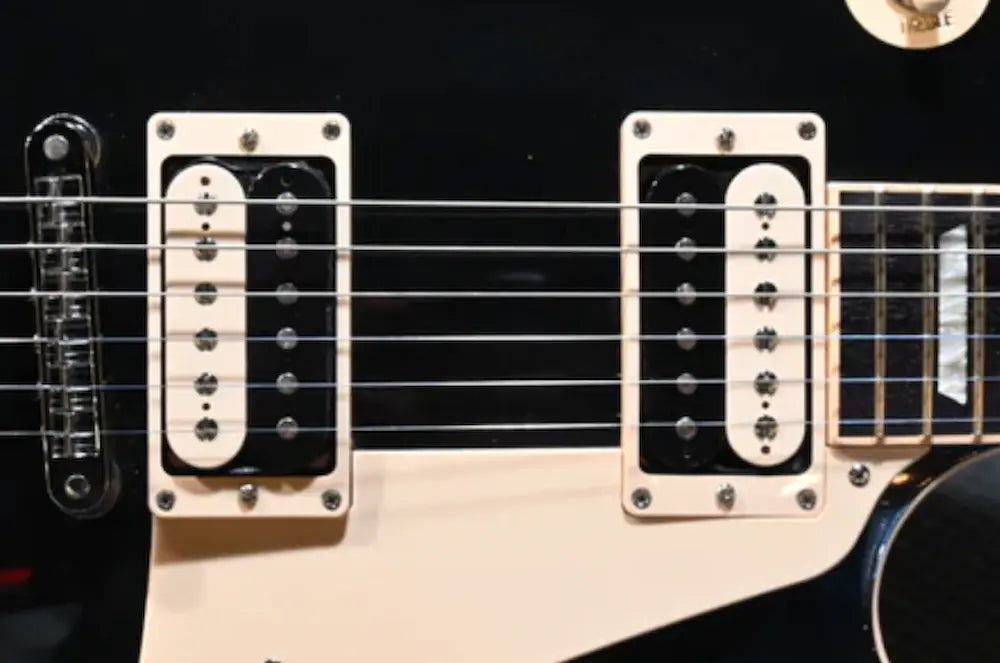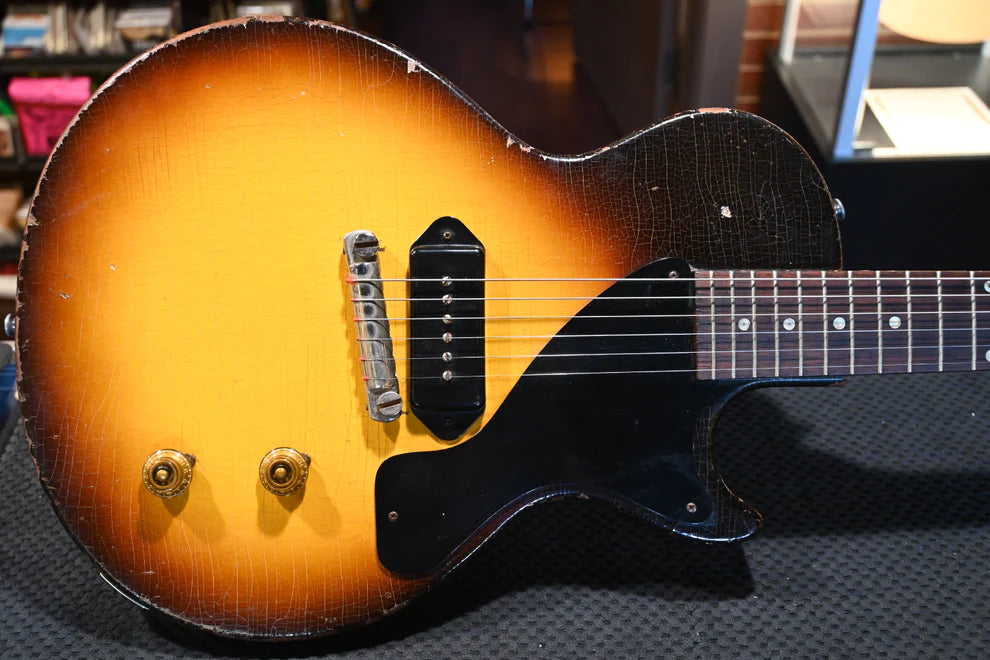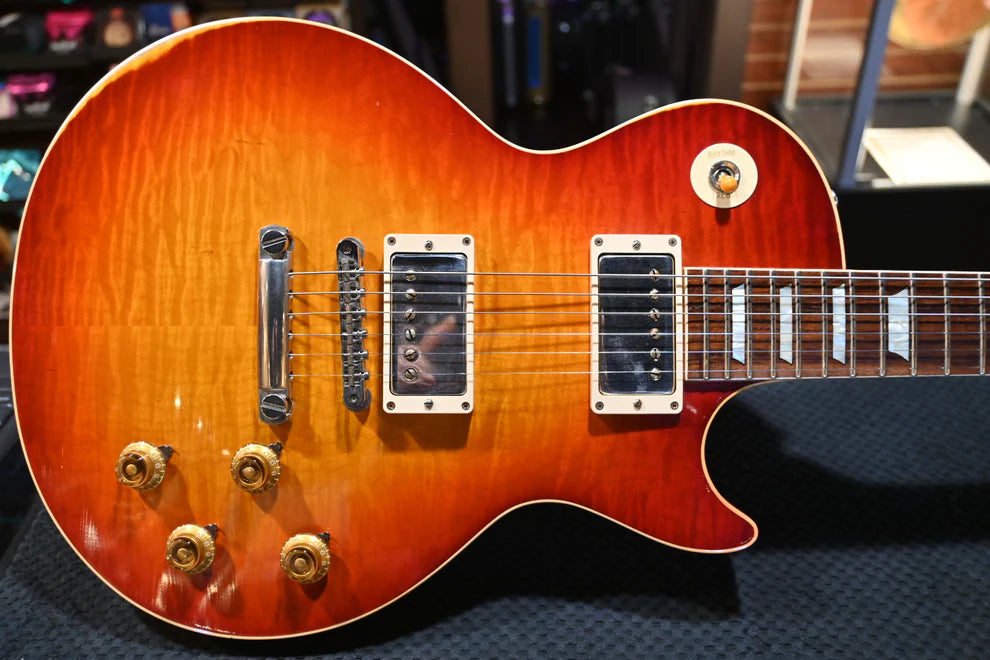The Gibson Les Paul guitar stands unmatched in its rich tone, versatility, and iconic design. Crafted with careful attention to detail, its body typically made from a solid piece of mahogany topped with carved maple gives it a sound that blends warmth and brightness effortlessly.
Surprisingly, despite modern advancements in guitar construction, the timeless single-cutaway design of this masterpiece hasn't changed much since the 1950s, keeping its rock and roll symbol status intact.
The Gibson Les Paul guitar is known for its iconic solid body construction, rich tone, and versatile sound. Its timeless design, quality craftsmanship, and the ability to cater to various music genres make it a sought-after choice for musicians worldwide.
The Iconic Gibson Les Paul Design
The Gibson Les Paul is not just a guitar; it's a timeless piece of art.
At first glance, its striking single-cutaway design and contoured edges give it a distinct shape. This classic design first made waves in the music world in the 1950s, and it has stood the test of time, maintaining its allure and remaining an emblem of rock and roll.
David Victor with his Les Paul Guitar on stage with BOSTON in 2014
The single-cutaway design isn't just for looks; it also serves a functional purpose. It allows easier access to the upper frets, enabling guitarists to perform intricate solos and melodies with ease—elevating your performance to new heights effortlessly.
This distinctive design sets it apart from other electric guitars, making it instantly recognizable on stage or in a music video.
But it's not just the shape that makes the Les Paul stand out – even its weight and feel have been meticulously designed to provide maximum comfort for the guitarist.
When you hold a Les Paul, you'll notice its substantial yet balanced weight, giving you a sense of stability as you play. The body contours make it rest comfortably against your body, allowing for long hours of playing without strain or discomfort.
It's also a very comfortable guitar to sit and practice on -- definitely a consideration if you're a student of the guitar!
Now that we've explored the exterior design, let's take a closer look at what makes the sound of the Gibson Les Paul truly exceptional.
Craftsmanship and Materials of the Les Paul
When it comes to crafting the iconic Gibson Les Paul, attention to detail is paramount. The body of this legendary electric guitar is meticulously constructed from solid mahogany, known for its rich, resonant qualities.
But what makes it truly special is the addition of a carved maple top, which not only enhances its visual appeal with stunning finishes but also contributes to a balanced tonal quality, providing warmth and brightness in its sound.
This careful combination showcases the unparalleled craftsmanship that goes into creating each Les Paul guitar.
The solid mahogany body lays the foundation for the guitar's rich, deep tone, while the carved maple top adds clarity and a brighter edge to its sound. This pairing creates a harmonious blend sought after by musicians across different genres.
The choice of these high-quality materials isn't just about aesthetics; it's about achieving a specific sonic character that has made the Les Paul a staple in the music world for decades.
Moving on to the neck of the Les Paul, we find another crucial element in the guitar's construction. Traditionally crafted from mahogany, the neck plays an essential role in defining the instrument's sustain and resonance.

The dense nature of mahogany contributes to its ability to carry vibrations, resulting in prolonged sustain and a full-bodied sound.
The smooth playability experienced on a Les Paul can be attributed to its rosewood fretboard. Known for its durability and comfortable feel, rosewood offers a lush, vibrant tone while ensuring effortless maneuverability across the fretboard.
It's important to note that each piece of wood used in crafting a Les Paul undergoes meticulous inspection and testing to ensure it meets Gibson's stringent standards for tonal quality, stability, and durability.
This level of scrutiny underscores the dedication to excellence that defines the construction process of every Les Paul guitar.
With every chord strummed and every riff played on a Les Paul, it becomes clear that these carefully chosen materials are not just components; they are essential contributors to the legendary sound and feel that define this iconic electric guitar.
As we continue our journey through the realm of the iconic Gibson Les Paul, let's now delve into an exploration of its key features that have become synonymous with musical excellence.
Key Features of the Iconic Les Paul Guitar
The Les Paul was designed to stand out in a crowd, and its unique features are part of what makes it such a powerhouse in the music world. Let's explore its key features one by one and see what sets it apart.
Humbucking Pickups
The heart of any electric guitar is its pickups, and the Les Paul's humbucking pickups are legendary for a reason. These innovative pickups provide a thick, rich tone that's resistant to interference or "hum."
 Humbucking pickups on a Les Paul guitar
Humbucking pickups on a Les Paul guitar
Humbucking pickups were a game changer in the world of electric guitars. By "bucking" the "hum" that could plague single-coil pickups, they opened up new possibilities for musicians. They give the Les Paul its signature sound—meaty and full-bodied, perfect for hitting those power chords or delicately plucking out melodic lines.
Set Neck Construction
The set neck design of the Les Paul is an essential component of its enduring legacy. This construction method involves fitting the neck and body together with precise joints for maximum solidity.
 Set neck design in Les Paul guitars
Set neck design in Les Paul guitars
It enhances the guitar's sustain and resonance, contributing to its renowned rich and full-bodied tone that resonates through every note played on it.
The seamless connection between the neck and body ensures excellent stability, which is crucial in maintaining the guitar's exceptional performance over time.
While other types of construction may have their benefits, the set neck design is favored for its tonal advantages. It facilitates a seamless transfer of vibrations between the neck and body, allowing the guitar to sing with remarkable sustain and resonance.
Mahogany Body with Maple Top
One of the most iconic elements of the Les Paul is its distinctive combination of a mahogany body with a maple top. This duo creates a balanced tonal spectrum unlike any other. The deep, resonant characteristics of mahogany complement the brightness and clarity provided by the maple top, resulting in a harmonious blend of warm lows and crisp highs that define the Les Paul's versatile sound.
This unique combination provides a sonic platform that suits various playing styles, from mellow jazz to high-energy rock 'n' roll. Each wood contributes distinct tonal qualities, adding depth and complexity to the instrument's overall sound.
Tune-O-Matic Bridge and Stopbar Tailpiece
Last but certainly not least are the hardware components that contribute significantly to the Les Paul's unmatched performance—the Tune-O-Matic bridge and stopbar tailpiece. These meticulously engineered components not only enhance the guitar's sustain and intonation but also allow for precise adjustments tailored to individual preferences, ensuring optimal playability for musicians across different genres.
The combination of these two components provides stability and fine-tuning capability, enabling players to achieve their desired action height, intonation, and string spacing. This level of precision and control is essential for maintaining a consistent playing experience whether you're strumming gentle chords or shredding blistering solos.
Each feature plays a pivotal role in defining the iconic sound and feel of the Les Paul, making it a staple in music history.
With an intimate understanding of what makes the legendary Les Paul tick, we now shift our focus to exploring its famous models—each holding a unique place in the annals of musical excellence.
Famous Models: Classic and Custom Les Paul
The iconic Les Paul boasts more than just one famous model; in fact, there are several that have left an indelible mark on music history. Each model possesses unique qualities that set it apart from the rest. Let's take a closer look at some of these renowned models:
Les Paul Standard

Gibson Les Paul Standard
The Les Paul Standard is renowned for its timeless sound and design. It features a mahogany body with a maple top, contributing to its rich and resonant tone. Additionally, this model is equipped with dual humbucking pickups, delivering a warm and full sound with reduced noise and interference. The set neck construction further enhances sustain and resonance, making it a favorite among guitarists across different genres.
Les Paul Custom
 Les Paul Custom
Les Paul Custom
Les Paul Junior
 Les Paul Junior
Les Paul Junior
Each of these models represents a different aspect of the Les Paul legacy, catering to diverse playing styles and sonic preferences. Whether it's the timeless appeal of the Standard, the sophisticated elegance of the Custom, or the bold simplicity of the Junior, these models have played an integral role in defining the sonic landscape of modern music.
Exploring these eminent models in detail reveals the diverse range of options offered by the Gibson Les Paul lineup for musicians seeking unparalleled craftsmanship and tonal excellence.

Looking for a piece of rock 'n roll history? Check out our stock of Gibson Les Paul guitars today.
Different Types of Gibson Les Paul for Various Players
Gibson has crafted a wide range of Les Paul models, each tailored to meet the unique needs and preferences of diverse guitar players. Whether you're an experienced musician or just starting out, there's a Les Paul designed just for you.
Les Paul Standard
The Les Paul Standard is a classic choice suitable for versatile players who appreciate a well-balanced tone that's ideal for rock, blues, and jazz. With its mahogany body featuring a carved maple top, dual humbucking pickups, and set neck construction, the Standard delivers the iconic Les Paul sound with modern playability.
Les Paul Traditional
Geared towards vintage enthusiasts who crave that classic, warm tone resonant of blues and classic rock, the Les Paul Traditional offers authentic features such as non-weight-relieved bodies, beautiful finish options, and unmatched craftsmanship, making it an excellent choice for those who cherish the heritage of the Les Paul legacy.
Les Paul Studio
Designed with a practical approach, the Les Paul Studio caters to budget-conscious players without compromising on playability. It presents a no-frills design focused on delivering exceptional performance across various genres. Its no-nonsense attitude makes it a popular choice among musicians seeking high-quality sound at an accessible price point.
Les Paul Custom
For professional musicians seeking a high-end, versatile tone, the Les Paul Custom stands as an exceptional choice. It's well-suited for rock, metal, and fusion styles with its premium features, including multi-ply binding, block inlays, and potent humbucking pickups. The Custom reflects Gibson's commitment to providing top-tier instruments for discerning artists.
Les Paul Junior
Ideal for beginners and punk rock players alike, the Les Paul Junior boasts a raw and stripped-down tone along with a simple design that's perfect for aggressive playing styles. Its straightforward approach resonates with those who prioritize attitude and simplicity in their musical expression.
Each variant offers a unique blend of features suited to different playing styles and preferences. Whether you're drawn to the timeless resonance of the Standard, the vintage charm of the Traditional, the affordability of the Studio, or the high-end performance of the Custom, there's a Les Paul model tailored specifically for you. Gibson's commitment to providing diverse options ensures that every guitarist can find their perfect match within the legendary Les Paul lineup.
As we've explored the diverse offerings from Gibson's iconic Les Paul lineup, let's now shift our focus towards mastering the art of playing this legendary instrument.
Playing Techniques for the Gibson Les Paul
The Gibson Les Paul is a guitar designed to explore diverse soundscapes. Let's take a closer look at the playing techniques that bring out the best in this legendary instrument. Whether you're looking to unleash aggressive power chords, shred soaring solos, evoke soulful blues, or express yourself through jazz playing, the Les Paul's solid body construction and sustain allow for an extraordinary range of musical expression.
When it comes to creating music with a Gibson Les Paul, varying picking styles is an essential technique. The guitar's rich sustain and resonant tone make it ideal for experimenting with different picking techniques. From pinpoint precision of alternate picking to the fluidity of legato playing, and the expressiveness of fingerpicking, the Les Paul allows musicians to craft nuanced melodies and intricate rhythms across various genres.
Blues guitarists adore the Les Paul for its ability to convey emotion and authenticity. Its warm, expressive tone lends itself well to bending notes, creating soul-stirring vibratos, and crafting searing slides. The Les Paul's responsive nature enriches each note with depth, allowing players to infuse their blues compositions with raw emotion and storytelling prowess.
Musicians seeking to venture into jazz find the Les Paul equally adaptable. Its ability to produce mellow tones and articulate notes paves the way for compelling chord melodies and sophisticated improvisation. Jazz players appreciate the resonance and clarity of each note produced by the Les Paul, enhancing their performance with subtle nuances and serene melodies.
Moreover, rock aficionados harness the Les Paul's sonic capabilities to deliver commanding performances. Chunky power chords resonate with authority while cutting through dense mixes. Guitarists unleash blistering tapped harmonics and sweeping arpeggios, courtesy of the Les Paul's powerful output and exceptional playability, energizing rock compositions with electrifying intensity.
In essence, the versatile nature of the Gibson Les Paul invites musicians to push musical boundaries across genres. From evocative blues licks to scorching rock riffs and expressive jazz passages, the Les Paul stands as a testament to creativity and artistry, offering a playground for musical innovation and sonic exploration.
In exploring the rich tapestry of sounds created using a Gibson Les Paul, one can't help but marvel at its influence on some of music's most iconic figures. Let's now turn our attention towards the famous musicians who have wielded their beloved Gibson Les Pauls to craft timeless tunes and shape musical history.
Famous Musicians and Their Gibson Les Paul Guitars
The remarkable sound and iconic appearance of the Gibson Les Paul have captivated some of the music industry's most prominent figures. From soaring solos to soulful rhythm sections, these artists have showcased the Les Paul's versatility across various musical genres.
Let's start with Jimmy Page. The legendary guitarist of Led Zeppelin is perhaps one of the most synonymous figures with the Les Paul. Page's custom 1959 Les Paul Standard, affectionately known as "Number One," played an integral role in crafting the band's distinct sound.
Page's powerful riffs and mesmerizing leads resonated with countless fans around the globe, cementing the Les Paul's place in rock history.
That famous poster didn't hurt either.
Known for his signature top hat and searing guitar licks, Slash of Guns N' Roses has also been closely associated with his "Appetite for Destruction" Les Paul model. The instrument's rich, full-bodied tone became an essential part of Slash's sonic identity, propelling him to superstardom during the height of Guns N' Roses' success.
"The Gibson Les Paul is a timeless piece, every note played on it is a whisper in history." - Jimmy Page
Another distinguished figure who has left an indelible mark is Joe Perry of Aerosmith. Perry gravitated towards a 1959 Les Paul Standard for its exceptional playability and tonal range. His mesmerizing performances and expressive style showcased the Les Paul's unparalleled ability to captivate audiences with its dynamic soundscape.
Moving to a different genre, Eric Clapton, largely known for his impeccable blues guitar work, found solace in the balanced resonance of the Les Paul Custom. Its warm, creamy overdrive complemented Clapton's emotive playing and set him apart as a pioneer in blues-rock fusion.
The list goes on! The legendarily under-appreciated Gary Moore, Billy Gibbons, and Peter Green are among many other artists who've chosen the Gibson Les Paul as their weapon of choice—each stamping their unique identity on the instrument and contributing to its everlasting legacy.
The connection between these artists and their beloved Gibson Les Paul models is more than mere endorsement. It's a testimony to the enduring allure and exceptional craftsmanship that defines the instrument.
The deep ties between these significant musicians and their cherished Gibson Les Paul guitars underscore its pivotal role in shaping modern music. Explore our website to discover a wide array of classic and contemporary Les Paul models, each offering a distinctive voice and character to complement your playing style.
Uncover your own journey with the timeless Gibson Les Paul at danvillemusic.com. Buy your dream Les Paul guitar today!
Trending Posts
Recent Posts
Best Guitar Amps Under $1000 for 2025
December 09, 2025
Best Guitars Under $500: Expert Picks for 2025
November 20, 2025


 Cameron Brochier
Cameron Brochier




